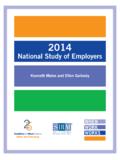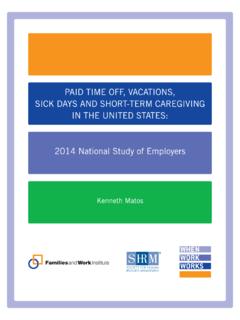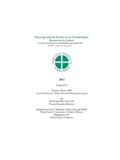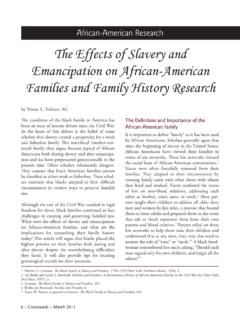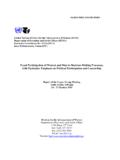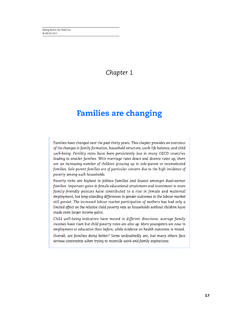Transcription of ACKNOWLEDGMENTS - Families and Work Institute
1 IACKNOWLEDGMENTSThe White House Forum on Workplace Flexibility on March 31, 2010 launched a national conversation on workplace flexibility. Continuing the momentum of this historic event, the Department of Labor s Women s Bureau hosted the National Dialogue on Workplace Flexibility, a series of ten forums around the country. With funding from the Alfred P. Sloan Foundation and the Ford Foundation, Families and Work Institute prepared a series of reports to accom-pany each of the Forums. These are being published by the When Work Works initiative of the Families and Work Institute (FWI) and the Society for Human Resource Management (SHRM).First, we give special thanks to the Alfred P.
2 Sloan Foundation and the Ford Foundation for supporting this report. We are deeply grateful to Kathleen Christensen from the Sloan Foun-dation and to Helen Neuborne and Anna Wadia from the Ford Foundation for their deep commitment to the issues of workplace flexibility and to employees, especially those who are least advantaged. Their wise counsel has affected our work and this report in countless and invaluable thanks to the incomparable Sara Manzano-Diaz, Director of the Women s Bureau, and to her talented and committed staff for offering us the opportunity to share this research at the National Dialogue on Workplace , we thank the nationally representative group of employees who responded to questions in the National Study of the Changing Workforce and the nationally representative group of employers who responded to the questions in the National Study of Employers.
3 We also want to thank the management and staff of Harris Interactive Inc. for their extraordinary efforts in carrying out the interviews for both of these studies. Finally, our thanks to the staff members of Families and Work Institute Tyler Wigton, Program Manager, Kelly Sakai, Program Manager, and James T. Bond, Research Advisor for their exemplary efforts in writing the eight National Dialogue on Workplace Flexibility reports with us. We also thank Lois Backon, Senior Vice President for her leadership; Kerstin Aumann, Senior Research Associate for her guidance; John Boose, Art Director for his design of the report and Barbara Norcia-Broms for her proof reading.
4 We also thank Carol Bryce-Buchanan and Marline Griffith for their support throughout the entire process and guidance for the dissemination of the findings. Special thanks as well to Morra Aarons-Mele of Women Online for working with us on the dissemination of our Flexibility in the United States: A Status Report Copyright 2011, Families and Work Assumptions about Workplace Trends in Workplace Potential of Workplace Of TAbLEST able 1: Short-Notice Schedule 2: Sick 3: Effects of Offering Flexible Work 4: Flexibility as a Favor for Individuals or a Business 5: Time 6: Workplace Flexibility and Time Famine among 7: Culture of 8: Overall Flexibility and Desire for 9: Overall Workplace Flexibility and Job 10: Overall Workplace Flexibility and Searching for a New 11.
5 Overall Workplace Flexibility and Physical 12: Overall Workplace American workforce has had a number of major transitions throughout history, when so-cietal, economic and technological trends transformed work, workers and workplaces. We are currently experiencing such a shift as increased workplace opportunities for women, invest-ment in home life by men, growing global economic pressures and continually improving com-munications technology alter the ways in which women and men manage their work, personal and family lives. In 1950, 34% of women ages 16 and older participated in the labor force. By 2010, this figure rose to 59% for women overall and 71% for women with Women now represent 49% of the wage and salaried workforce.
6 Simultaneously, the percentage of couples with both mem-bers employed outside the home has risen from 66% in 1977 to 80% in 2008. On average, these women in dual-earner couples provide 45% of their total household income. Despite their greater involvement in the workforce women have not substantially reduced their involve-ment at home. For example, mothers spend the same number of weekday hours with their children ( ) in 2008 as they did in 1977 and the majority of married/partnered women report doing most of the cooking (70%) and cleaning (73%) in their households. Just as women have endeavored to find ways to fit their work, personal and family lives to-gether, so have men.
7 From 1977 to 2008, the average workday time fathers spent with their children increased significantly from 2 to hours and their time doing household chores also increased significantly from to hours a day. In 2008, 49% of employed men with Families reported experiencing some or a lot of work-family conflict, a significant increase from 1977 (34%).2 The growth in work-family conflict was especially pronounced among four groups of men where at least 60% reported experiencing some or a lot of work-family conflict: Men working 50 or more hours a week Men with high job demands Men with a work-centric worldview Fathers in dual-earner couplesAs these data show, the search for a good work-life fit is a challenge that faces many employees today, both men and women.
8 Employers who address this challenge and help their employ-ees work more flexibly are more likely to be productive, competitive and profitable in the 21st To encourage employers to consider how they can garner the benefits of flexibility for their businesses and their employees, the White House Council on Women and Girls hosted The White House Workplace Flexibility Forum in 2010. The forum assembled a diverse, accom-plished group from academia, labor, government, media, nonprofits and business to consider how private and public enterprises could best meet the challenge of more flexible conversations that began at the national forum were continued in local gatherings around the country.
9 The Women s Bureau of the Department of Labor took the lead in this process, convening the National Dialogue on Workplace Flexibility (NDWF), a series of forums on work-place flexibility that brought together stakeholders in multiple communities across the nation. Attendees of the National Dialogue s forums included: employers community leaders government agencies and officials unions researchers policy advocates concerned all of whom contributed to the discussion of how to meet the challenges of providing greater workplace flexibility while simultaneously attaining organizational and Work Institute (FWI) staff participated in each of the forums as keynoters, discussion group members and/or subject matter experts.
10 In addition, FWI distributed original research reports tailored to the topics of each NDWF forum. FWI s reports de-scribed the workplace flexibility options available in different industries and among em-ployees with varying employment characteristics as well as the impact that flexibility has on a number of outcomes of interest to employers and employees alike. This summary report includes key findings from the topic-specific reports, along with new information to highlight common assumptions not supported by FWI s data, emerging trends, and the relationship of flexibility to various outcomes. The findings in this and the other NDWF reports are drawn from FWI s two nationally represen-tative surveys: the National Study of the Changing Workforce (NSCW)4 and the National Study of Employers (NSE).
